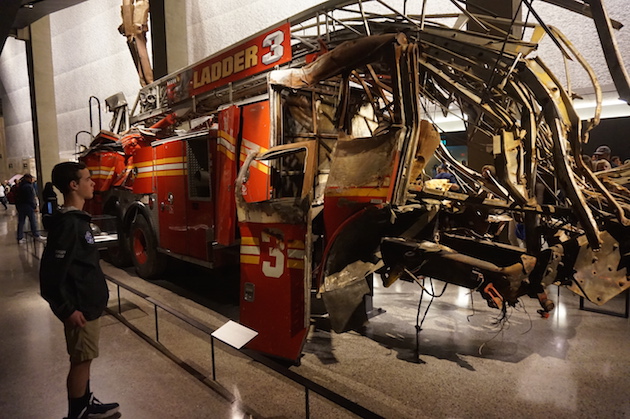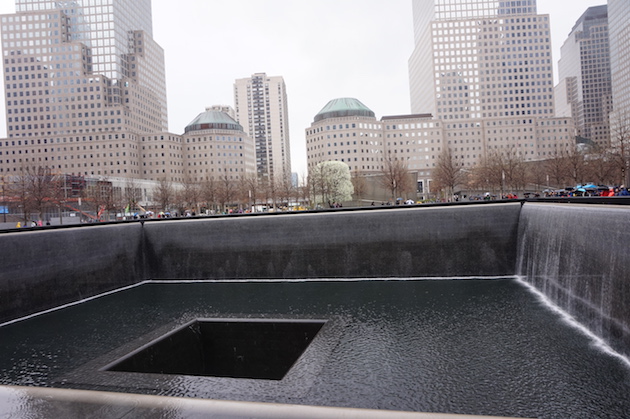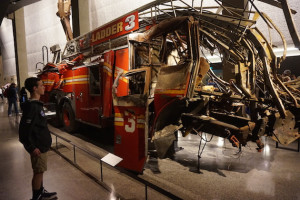Why the National 9-11 Memorial and Museum matters

Fifteen years after the attacks of September 11, 2001, we visit the National 9/11 Memorial in New York to discover why it matters to every American.
–By Dwight Widaman
As we approached the site of the National September 11 Memorial and Museum, my heart quickened. I could feel that something big–very big–use to occupy this space on Manhattan Island. I looked up into the chilly, overcast April sky and imagined the tops of the World Trade Towers disappearing into the clouds.
Accompanied by good friends, Mark and Julie Johnson, who moved to Connecticut from Lee’s Summit the year after 9-11, Anita and I had looked forward to experiencing the exhibits with them. I told them this was the most important thing I wished to see. And, there is so much to see, though I didn’t realize how much we would feel.
 Visitors step up to a waist-high ledge to view giant reflecting pools built in the exact location of the towers 50-feet below. Water cascades down the sides from underneath the bronze ledge that memorializes the names of all those lost in the World Trade Center Towers, Pentagon, Flight 93 and from the attacks in 1993.
Visitors step up to a waist-high ledge to view giant reflecting pools built in the exact location of the towers 50-feet below. Water cascades down the sides from underneath the bronze ledge that memorializes the names of all those lost in the World Trade Center Towers, Pentagon, Flight 93 and from the attacks in 1993.
As the water falls, it catches the edge of the stone blocks creating a spray that mimics the iconic facade of the buildings. Anita notices that it is quiet. Not quiet as in the absence of noise but quiet as visitors to the memorial contemplate the names of victims. You hear only water as the sounds of New York City fade to nothingness in the distance. This water, plus emotions that spring from within one’s heart, create a sacred space in the city that never sleeps.
We slowly walked around the memorial, letting our fingers trail gently and reverently across names of the 2,983 victims etched in bronze.
Nearby, a building that seems to jut out from the plaza, allows entrance to the museum atrium below. There you’ll first see the concept of design of the World Trade Towers–an iconic architectural symbol of America’s strength, power and ingenuity. You can’t miss a wall-size photo of the towers and surrounding area taken just moments before the first impact.
The exhibit is divided into three time periods: the day it happened (9/11), the immediate aftermath (post-9/11) and pre-9/11. The last displaying the historical context.
Several things stand out and they remind me this should be considered one of the most important national memorials in our nation. It is certainly one of the most hallowed.
 The museum is a somber place. People speak in hushed tones, if they speak at all. Young people instinctively slip their phones into pockets. Scattered throughout are tissues for those overcome with emotion.
The museum is a somber place. People speak in hushed tones, if they speak at all. Young people instinctively slip their phones into pockets. Scattered throughout are tissues for those overcome with emotion.
I have not experienced a weight on my heart such as this since the day I visited Yad Vashem–World Holocaust Remembrance Center in Jerusalem. While separated by six decades, both the Yad Veshem and 9/11 Museums show that evil is alive in the world and humanity still pays the price. But for me, and you, this is an event we lived through, if only through television for most of us. Yet, so powerful were feelings of Americans that day and the weeks to follow, it changed our national psyche. We are still struggling with those emotions and the political decisions they wrought.
And those emotions still come as you see up-close, even to touch, the crushed fire trucks and steel girders; videos of helpless people leaping to their deaths; and hear the frantic voicemails that plane passengers, office workers and rescuers left for loved ones.
One powerful feature of the museum is that it is built around and in the footprints of the towers. Framed by the pylons driven into bedrock, the outer area represents more general information but once you step across the footprint, you are transported literally into the building and the experience is personal. You see the individuals, their stories and frantic last moments of life.
 The exhibit allows you to be transported back in time viewing a wall of preserved missing persons posters, Ladder Company 3’s crushed fire truck and the slurry wall, which still holds back the Hudson. Other powerful objects on display are the suspended twisted exterior beams of Tower One that show, without doubt, where the plane hit. There are also windows and seats from the planes, clothing and shoes, and crushed personal belongings.
The exhibit allows you to be transported back in time viewing a wall of preserved missing persons posters, Ladder Company 3’s crushed fire truck and the slurry wall, which still holds back the Hudson. Other powerful objects on display are the suspended twisted exterior beams of Tower One that show, without doubt, where the plane hit. There are also windows and seats from the planes, clothing and shoes, and crushed personal belongings.
One of the most powerful rooms is The Memorial Exhibition displaying photos of all those lost. Here, in hart-wrenching detail, you see up-close the faces and personalities of the victims.
Towards the end, as if to wake you from a sad dream, you come upon America at its finest as the nation responded as best we could. Here is the 9/11 Quilt and 9/11 Flag that made its way across the nation, being mended by thousands of ordinary Americans along the way, including pieces of a flag that remained intact from the Joplin tornado.
This is a difficult memorial and exhibit to view. Anita says it brings an eruption of emotions from your innermost soul. She is right. But, it is something that each American should experience if they can.
“There is so much to see, one could spend an entire day and not see everything in the museum. However, after two hours, I needed to leave. It still is unbelievable and sickening,” our friend Julie shared with us recently.
“My thoughts and prayers go out to loved ones as we approach yet another anniversary of that tragic day,” she said.
And so are ours as we remember together.
The museum has an extensive website with a tremendous amount of resources including videos. Visit www.911memorial.org for more info.







